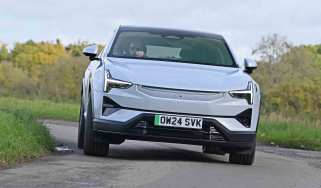Mercedes CLA Shooting Brake review
The Mercedes CLA Shooting Brake is an estate version of the stylish and compact CLA

The Mercedes CLA Shooting Brake is a more spacious and more practical version of the CLA saloon. On paper, it offers more bootspace than a C-Class estate, but the sloping roofline limits rear-seat headroom and compromises outright load capacity.
Following the success of its larger CLS Shooting Brake, Mercedes painted the baby CLA with the same brush. Looks won’t be to all tastes, but there’s no denying the Shooting Brake casts a striking profile. It gets the same front end as the standard CLA, but from the B-pillar back, the higher roofline marks this out as the slightly more versatile estate model.
Merc’s habit of finding a niche within a niche means rivals in this market are few and far between. As a result the CLA Shooting Brake must compete with cars like the Volkswagen Golf Estate, Honda Civic Tourer – or even the Audi Q3 or BMW X1.
It gets the same range of engines as its four-door sibling, meaning a choice of three petrols and two diesels. The entry-level 1.6-litre turbo CLA 180 is the cheapest model, while the 2.0-litre turbo CLA 250 is faster and comes with 4MATIC four-wheel drive. Those looking for cheaper running costs should look at the 2.1-litre (CLA 200 and CLA 220 CDI) diesels, though true driving thrills are reserved for the flagship CLA 45 AMG.
Used - available now

2023 Kia
Sportage
26,478 milesAutomaticPetrol1.6L
Cash £26,497
2022 Nissan
Qashqai
36,002 milesAutomaticPetrol1.3L
Cash £16,697
2023 Audi
e-tron Sportback
26,067 milesAutomaticElectric
Cash £26,676
2023 Mercedes
EQC
13,012 milesAutomaticElectric
Cash £29,600Trim levels comprise Sport, AMG Sport, OrangeArt and ‘Engineered by AMG’. The latter features 18-inch AMG alloy wheels, lowered sports suspension and red styling details, while the full-fat CLA 45 AMG Shooting Brake tops the range as a standalone model. The OrangeArt trim adds orange highlights to the wheels, bumpers and interior, and makes the already eye-catching CLA frankly unmissable.
Engines, performance and drive
While many may love the CLA’s looks, few will wax lyrical about the way this small estate drives.
The front-wheel-drive setup isn’t the Merc’s downfall, but the inaccurate and lifeless steering, along with the firm suspension and body roll, are. It’s a shame really, because the new C-Class is right up there with the best cars in its class, but this CLA feels somewhat off the pace.
The electric power steering doesn’t provide much feedback, and even on the entry-level car’s 18-inch wheels, the ride is unacceptably firm. The suspension setup is exactly the same as on the saloon, albeit slightly tweaked to cope with the Shooting Brake’s extra weight. It’s certainly worth specifying the lowered comfort suspension if you spend a lot of time behind the wheel.

Diesel cars get a 2.1-litre engine, with either 134bhp or 176bhp. Both feel rattly and unrefined around town, and gruff under hard acceleration. They settle down on the motorway, though the petrol cars are quieter and should return decent miles per gallon with a lighter right foot. None are great fun to drive, but unless you cover big miles, we’d go for one of these.
It’s a different story on the range-topping CLA 45 AMG Shooting Brake. The 355bhp turbocharged 2.0-litre four-cylinder engine is a hoot to drive, with bags of grunt from low down in the rev range. The steering feels much sharper too, and it doesn’t jitter around as much as the standard car. If you can afford it, this is the CLA Shooting Brake to go for.
All cars offer a well-insulated cabin, meaning wind and road noise are kept to a minimum, while the seats provide a decent amount of support.
MPG, CO2 and Running Costs
The Mercedes CLA is available with a range of small petrol and diesel engines, all of which return decent mpg, meaning none should cost the earth to run.
Best of all is the CLA 200 CDI, with the seven-speed dual-clutch automatic gearbox. This car will do 68.9mpg and emit 106g/km, while the manual model returns 65.7mpg and 111g/km. Next up is the 220 CDI, which does 67.3mpg/108g/km – and is only available as a seven-speed DCT. All diesel cars share
Petrol models are quieter and smoother, though inevitably they’ll cost more to run. The CLA 180 uses a 1.6-litre turbocharged engine and can return 48.7mpg and 128g/km of CO2. The more powerful four-wheel drive CLA 250 does 42.8mpg, which in all honesty isn’t too far off the range-topping CLA 45 AMG. If your budget will stretch, this is the CLA of choice – returning 39.8mpg and 161g/km of CO2.
All this style doesn’t come cheap, though. It’s around £1,000 more than the saloon, with prices starting at £25,755 for the CLA 180 Shooting Brake Sport. The range-topping CLA 45 AMG will cost you almost as much as a Porsche Cayman S – especially when you’ve accounted for a few choice options. If you really need the space, take a look at the BMW 335i Touring.
Interior, design and technology
While the Mercedes CLA Shooting Brake’s looks won’t be to all tastes, there’s no denying it cuts a sharp profile. From the front it looks identical to the four-door saloon, but from the side, the higher roofline and swept-back looks are clear for all to see.
Don’t be fooled by the slightly boxier styling, though. This CLA Shooting Brake is a fashion statement more than it is a practical load-lugger. The sloping roof eats into interior space and the sleek rear lights mean the boot opening is far less square than you’d expect from a normal estate car.
Inside, the dashboard has been lifted straight from the standard CLA. That means the same iPad-style central screen glued to the dash, and identical buttons for the stereo and navigation controls. The petrol and diesel cars get a steering-wheel mounted gearshifter, while the CLA 45 AMG, gets a beautifully detailed joystick-style lever on the centre console. It’s not the last word in quality, but the CLA easily holds its own in this part of the market.
Practicality, comfort and boot space
You’d expect the estate version of any car to offer improved practicality over the standard car, and the same is true of the CLA Shooting Brake.
However, it’s worth noting that this is a car that values form over function, with that sleek sloping roofline eating into interior space. Mercedes claims a 495-litre boot, which on paper is not only 25 litres bigger than a CLA saloon – but also five litres larger than the C-Class Estate. For £545 Merc will offer you a Load Compartment Package, allowing owners to fix the rear seats in a more upright position – resulting in another 100 litres of bootspace. Don’t be fooled though, the obtrusive rear light clusters make loading tricky, while folding down the seats reveals a not-so-huge 1,354 litres (compared to 1,510 in the C-Class).

Rear headroom is improved by 40mm, but taller passengers will still find their heads rubbing the ceiling and their knees brushing the seat in front. Yes there’s more space inside, but conventional estate cars are still more practical.
Up front, there's plenty of storage space dotted around the cabin, while the electric parking brake and steering wheel-mounted gear lever free up space for a roomier cockpit.
Reliability and Safety
As with the saloon, the Mercedes CLA Shooting Brake is based on the A-Class hatchback. That car has been on sale since 2011, meaning any teething troubles should now have been ironed out – hopefully making the CLA a reliable car.
This is backed up by an impressive brand performance in the 2014 Driver Power survey, with Merc finishing 9th overall, ahead of major rivals Audi and BMW. Neither the A-Class or CLA made an appearance in the top cars – probably due to their infancy – but expect a strong showing in the 2015 survey.
Standard safety kit on the CLA includes a host of airbags and Isofix child seat mountings. All cars also feature collision prevention assist and attention assist. All of this safety tech led to the saloon achieving a full five-star rating from crash test experts Euro NCAP in 2013.








